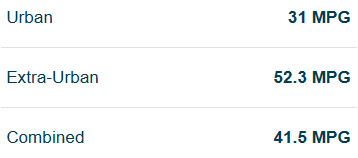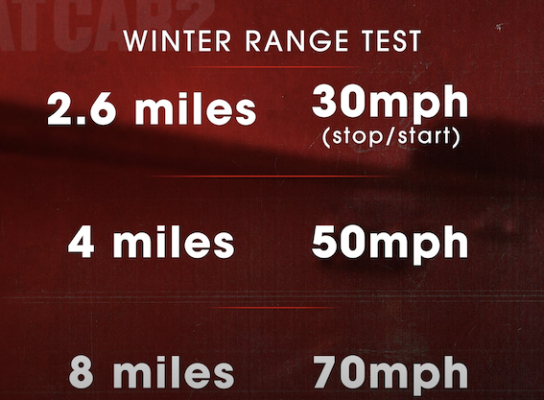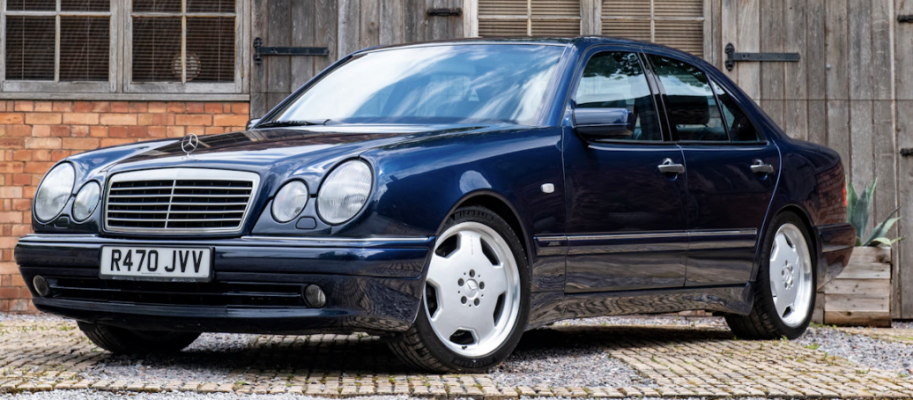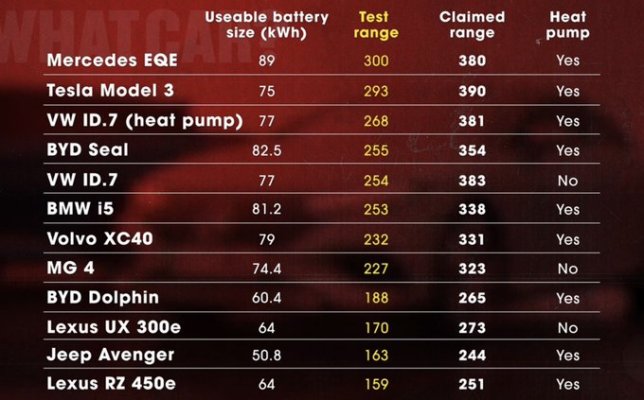Navigation
Install the app
How to install the app on iOS
Follow along with the video below to see how to install our site as a web app on your home screen.
Note: This feature may not be available in some browsers.
More options
You are using an out of date browser. It may not display this or other websites correctly.
You should upgrade or use an alternative browser.
You should upgrade or use an alternative browser.
The EV fact thread
- Thread starter Petrol Pete
- Start date
- Joined
- Jun 24, 2008
- Messages
- 49,586
- Location
- London
- Car
- 2022 Hyundai IONIQ 5 RWD / 2016 Suzuki Vitara AWD
View attachment 154208
Figures are from real world tets carried out recently by Whatcar.
The cars were driven around Millbrook untill they ran out of charge.
The ASA should be taking a serious look at manufacturers claims, since the figures are all in the order of 100 miles short of the claims.
As long as the manufacturers state that the actual range may vary (as they do regarding official mpg figures for ICE cars), ASA won't get involved.
As long as the manufacturers state that the actual range may vary (as they do regarding official mpg figures for ICE cars), ASA won't get involved.
That's the test I posted previously. Need to bear in mind that this involved driving until the vehicle was stranded by the side of the road - stopping at say 5-10% charge remaining would give a more realistic (but lower) range figure.
For sure ICE cars often don't give fuel consumption matching their official 'combined' figure, but are they 30-40% out as most of the ones in this test were?

MikeInWimbledon
Hardcore MB Enthusiast
- Joined
- Nov 8, 2014
- Messages
- 13,536
- Car
- (Ex S211 E500, W212 E500, C216, S212 E500, W211 E500 5.5, W221 S500, S211 E500, SL500, S500, E55)
This is important because all my mileage is done on Test tracks driving round at speed.View attachment 154208
Figures are from real world tets carried out recently by Whatcar.
The cars were driven around Millbrook untill they ran out of charge.
The ASA should be taking a serious look at manufacturers claims, since the figures are all in the order of 100 miles short of the claims.
Do we have the same test for ICE vehicles driven at standard speed round and round on a test track?
- Joined
- Sep 27, 2016
- Messages
- 13,416
- Location
- UK
- Car
- Tesla Model S, Model 3 LR, Model X /// Previous: Jaguar XFR, Mercedes E320 CDI, C32 AMG, CLK 320
See 40 seconds inAye, and the answer to my question?
Is an ICE safer? (Because they're less prone to excess electrickery). I don’t know the answer.
- Joined
- Jan 21, 2005
- Messages
- 30,226
- Location
- Mittel England
- Car
- Smart ForFour AMG Black Series Night Edition Premium Plus 125 Powered by Brabus
For those concerned about escaping a trapped car underwater, you can pick up two life hammers from Amazon for less than a tenner.
Currently Amazon’s own brand are just £9.23 for a pair, and that’s including delivery but I’ve paid less than £8.00 in the past, and that’s for two.
They are perfect for cutting belts, breaking glass and keeping handy for any emergency situation in which your life or safety is threatened..
Currently Amazon’s own brand are just £9.23 for a pair, and that’s including delivery but I’ve paid less than £8.00 in the past, and that’s for two.
They are perfect for cutting belts, breaking glass and keeping handy for any emergency situation in which your life or safety is threatened..
MikeInWimbledon
Hardcore MB Enthusiast
- Joined
- Nov 8, 2014
- Messages
- 13,536
- Car
- (Ex S211 E500, W212 E500, C216, S212 E500, W211 E500 5.5, W221 S500, S211 E500, SL500, S500, E55)
And particularly useful on husbands.For those concerned about escaping a trapped car underwater, you can pick up two life hammers from Amazon for less than a tenner.
Currently Amazon’s own brand are just £9.23 for a pair, and that’s including delivery but I’ve paid less than £8.00 in the past, and that’s for two.
They are perfect for cutting belts, breaking glass and keeping handy for any emergency situation in which your life or safety is threatened..
Seriously, boys and girls, do the numbers.
How likely are you - personally - likely to be married to a billionaire, and inadvertently selecting reverse while drunk as a skunk, and the ending up in a large deep pond on your ranch, panicking about how to get out?
There are many ways to end our days early.
The main ones are curry, cigarettes, drugs and alcohol. Not reversing a motor into a deep pond.
Petrol Pete
Hardcore MB Enthusiast
See 40 seconds in
At least it wasn't on fire.
Bellow
Hardcore MB Enthusiast
If it came to it, safer to wait until there's just enough airspace for one deep breath before opening the door and exiting. If the door is opened or glass broken before the car is almost completely full, the sudden ingress of water will be your undoing.For those concerned about escaping a trapped car underwater, you can pick up two life hammers from Amazon for less than a tenner.
That, and the risk of getting snagged on broken glass trying to exit via a broken window.
This is important because all my mileage is done on Test tracks driving round at speed.
I posted details of the test when this was first published - it involved lower speeds as well, including a 30 mph stop/start section with regen braking. There was also a stop at the end of each 15 mile route to change the driver, so far from continuous laps of a test track.
Do we have the same test for ICE vehicles driven at standard speed round and round on a test track?
As above that's not what the What Car? test involved. But yes ICE cars generally have a range of official fuel consumption figures, including an 'extra urban' one at higher speeds. As mentioned they are often a bit optimistic, but not typically by 30-40%.
Just checked our 2019 C300 and the official figures are:

Since the last refill it has done 486.2 miles, largely short local trips but with a couple of 80 mile motorway trips to the NEC and back in pretty nasty weather. The average consumption is 34.9 mpg, which is 84% of the official 'combined' figure. That's a 5 year old car of course - I assume most EVs would have lost a bit of range by then (the cars tested were all new 73 plate ones).
MikeInWimbledon
Hardcore MB Enthusiast
- Joined
- Nov 8, 2014
- Messages
- 13,536
- Car
- (Ex S211 E500, W212 E500, C216, S212 E500, W211 E500 5.5, W221 S500, S211 E500, SL500, S500, E55)
So 16% lower range than the claimed figure.I posted details of the test when this was first published - it involved lower speeds as well, including a 30 mph stop/start section with regen braking. There was also a stop at the end of each 15 mile route to change the driver, so far from continuous laps of a test track.
As above that's not what the What Car? test involved. But yes ICE cars generally have a range of official fuel consumption figures, including an 'extra urban' one at higher speeds. As mentioned they are often a bit optimistic, but not typically by 30-40%.
Just checked our 2019 C300 and the official figures are:
View attachment 154232
Since the last refill it has done 486.2 miles, largely short local trips but with a couple of 80 mile motorway trips to the NEC and back in pretty nasty weather. The average consumption is 34.9 mpg, which is 84% of the official 'combined' figure. That's a 5 year old car of course - I assume most EVs would have lost a bit of range by then (the cars tested were all new 73 plate ones).
Do you think you could sue the manufacturer?
The Tesla might “appear”to be25% lower, but those conditions are skewed against it, being both Winter and non-Urban. Test the Tesla in May with some city driving and that 25% difference would be close to 5%
(I still hate the Tesla 3 v1.0, but not for its range at 5p at mile)
Last edited:
- Joined
- Jun 24, 2008
- Messages
- 49,586
- Location
- London
- Car
- 2022 Hyundai IONIQ 5 RWD / 2016 Suzuki Vitara AWD
...But yes ICE cars generally have a range of official fuel consumption figures, including an 'extra urban' one at higher speeds. As mentioned they are often a bit optimistic, but not typically by 30-40%...
Just to add that the fluctuations go both ways... at least on my IONIQ 5. On a warm day in slow moving traffic the remaining mileage displayed can exceed the WLTP figure by 20%.
My view is that the idea of a single figure, derived from ICE car 'official mpg' standard, is simply not fit for use with EVs, where the actual energy consumption varies greatly (and, when going dowhill, the battery actually get charged....).
So 16% lower range than the claimed figure.
Yes.
Do you think you could sue the manufacturer?
No idea, perhaps if the difference was double that or more?
The Tesla might “appear”to be25% lower, but those conditions are skewed against it, being both Winter and non-Urban.
Sure. What Car? were specifically testing 'winter' range though (although only at 11C). And the Model 3 was in the configuration that Tesla claims gives a 421 mile range, so actually 30% lower. That wasn't the worst example - the two Lexus models were down 37 and 38% on their 'book' ranges, and the ID.7 and Jeep down 34 and 33% respectively. And remember that's to the point where the cars had to be recovered on a flatbed ... in real life nobody would ever drive that far on a charge.
Test the Tesla in May with some city driving and that 25% difference would be close to 5%
Test my C300 in warmer/drier conditions and the mpg on that would probably be closer to the official figures too. And test a Tesla of the same age and the chances are it would have lost a bit of battery capacity.
(I still hate the Tesla 3 v1.0, but not for its range at 5p at mile)
I don't hate any EVs. I just don't want to buy one right now
MikeInWimbledon
Hardcore MB Enthusiast
- Joined
- Nov 8, 2014
- Messages
- 13,536
- Car
- (Ex S211 E500, W212 E500, C216, S212 E500, W211 E500 5.5, W221 S500, S211 E500, SL500, S500, E55)
You should test drive the Tesla 3 v1.0. It's dreadful.I don't hate any EVs. I just don't want to buy one right now
It's great to save the money on fuel and eliminate most of those 24 trips to petrol stations each year, but Tesla's first effort at a C Class competitor is dreadful.
MikeInWimbledon
Hardcore MB Enthusiast
- Joined
- Nov 8, 2014
- Messages
- 13,536
- Car
- (Ex S211 E500, W212 E500, C216, S212 E500, W211 E500 5.5, W221 S500, S211 E500, SL500, S500, E55)
Aye, and put your C300 in City stop start conditions and it won't be anyway near official average range figures.Test my C300 in warmer/drier conditions and the mpg on that would probably be closer to the official figures too. And test a Tesla of the same age and the chances are it would have lost a bit of battery capacity.
ICE underachieve in Cities, while EV's overachieve.
Which is why driving EV's at steady speeds on test tracks mean so little to people who don't spend their life driving at steady speeds.
- Joined
- Jun 24, 2008
- Messages
- 49,586
- Location
- London
- Car
- 2022 Hyundai IONIQ 5 RWD / 2016 Suzuki Vitara AWD
Aye, and put your C300 in City stop start conditions and it won't be anyway near official average range figures.
ICE underachieve in Cities, while EV's overachieve.
Which is why driving EV's at steady speeds on test tracks mean so little to people who don't spend their life driving at steady speeds.
...or uphill and downhill.
Just to add that the fluctuations go both ways... at least on my IONIQ 5. On a warm day in slow moving traffic the remaining mileage displayed can exceed the WLTP figure by 20%.
My view is that the idea of a single figure, derived from ICE car 'official mpg' standard, is simply not fit for use with EVs, where the actual energy consumption varies greatly (and, when going dowhill, the battery actually get charged....).
Agreed - it all depends on your usage pattern. Perfect for urban driving, but worse than people are led to believe in an extra-urban environment with less regen. (particularly at higher speeds and with heating on (pretty sure the WLTP cycle is based on no heating/aircon use).
Which is why driving EV's at steady speeds on test tracks mean so little to people who don't spend their life driving at steady speeds.
Which is why What Car? didn't do that.
Interesting interview with James May:
MikeInWimbledon
Hardcore MB Enthusiast
- Joined
- Nov 8, 2014
- Messages
- 13,536
- Car
- (Ex S211 E500, W212 E500, C216, S212 E500, W211 E500 5.5, W221 S500, S211 E500, SL500, S500, E55)
Nope, WhatCar did exactly that.Which is why What Car? didn't do that.
82% of the mileage was done at steady speeds on a flat circular test track.
As I said, right at the beginning, compare like for like, ICE to EV. Don't misquote performance in disadvantaged conditions: cold, high speed driving, with heaters on at 21 degrees C.
I used to get 9mpg from my W210 E55 during December and January on the 2 mile School run in near freezing temperatures. But that 170 mile tank range wasn't any reason to sue Mercedes for false claims.

1998 E55: Real world range: 170 miles (17 gallons)

Last edited:
Users who are viewing this thread
Total: 1 (members: 0, guests: 1)
Similar threads
- Replies
- 26
- Views
- 3K
- Replies
- 263
- Views
- 16K

